Jade History And Traditions
 The name jade refers two to gemstones, nephrite and jadeite. Most people today prefer jadeite jade, but this was not the case for thousands of years. Humans have have known jade for at least 6,000 to 7,000 years, nephrite was in high demand and it was mined in a number continents and locations. The name 'jade' was derived from the Spanish language, the Spaniards believed that jade and more specifically nephrite jade, could relieve the kidneys of disorders and ailments. Jade began to be closely associated with Chinese culture and traditions, this started more than 6,000 years ago. Much of Chinese jade during those times was mined in the country itself, it was nephrite and not jadeite that was highly valued. The Chinese believed that jade could connect the body as a physical form, to the spiritual realm. The gem earned high respect and was referred to ass 'yu'', which could be interpreted as, 'the golden gem' or the 'royal gem'.
The name jade refers two to gemstones, nephrite and jadeite. Most people today prefer jadeite jade, but this was not the case for thousands of years. Humans have have known jade for at least 6,000 to 7,000 years, nephrite was in high demand and it was mined in a number continents and locations. The name 'jade' was derived from the Spanish language, the Spaniards believed that jade and more specifically nephrite jade, could relieve the kidneys of disorders and ailments. Jade began to be closely associated with Chinese culture and traditions, this started more than 6,000 years ago. Much of Chinese jade during those times was mined in the country itself, it was nephrite and not jadeite that was highly valued. The Chinese believed that jade could connect the body as a physical form, to the spiritual realm. The gem earned high respect and was referred to ass 'yu'', which could be interpreted as, 'the golden gem' or the 'royal gem'.
It was about 300-400 years ago that Burma revealed its jadeite resources, much of this was concentrated in the northern parts of the country. The gem was jadeite jade and not nephrite, fine specimens showed a stunning green color and a high degree of translucence. The finest of the fine Burmese jadeite was labelled as Imperial Jade. Some of this jade traveled to China, what followed is truly amazing. The Chinese quickly started to discount the importance and significance of nephrite jade, they set their sights on Burmese jadeite jade. The Chinese passionate romance with jadeite keeps growing stronger, this remains true even today. Almost all gem quality jadeite in the world, comes from the Burmese mines. A tiny portion of rough jadeite can yield fine quality jadeite gems. As expected, the price of high quality jadeite jade from Burma is high, it can often match the per carat price of diamonds. Needless to say that the extravagantly priced jadeite finds its way into China, the Chinese value the gem for its significance and meaning.
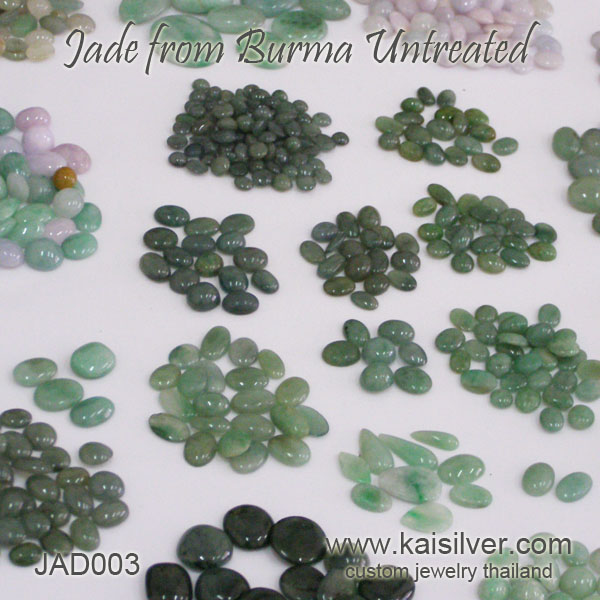 Jade has an internal composition that, makes it extremely tough and durable. The gem is made up of very fine fibers that are interwoven, this adds to the toughness of the gemstone. The earliest recorded use of jade was not related to gems and jewelry, ancient humans used the stone to carve out weapons and tools. Jade takes on a nice polish, gem cutting experience and expertise are required to bring out the true beauty of the gemstone. Gem and crystal healers claim that, jade symbolizes true love and loyalty. Many European nations and even the U.S wear jade for its color and mystical beauty. A significant number of consumers in these regions are quite open to the concept of dyed and enhanced jadeite jade. This is therefore a market where, low to medium priced jade gems sell well. This is very unlike the Chinese markets where high quality untreated jadeite costing, several thousand dollars per carat does brisk business.
Jade has an internal composition that, makes it extremely tough and durable. The gem is made up of very fine fibers that are interwoven, this adds to the toughness of the gemstone. The earliest recorded use of jade was not related to gems and jewelry, ancient humans used the stone to carve out weapons and tools. Jade takes on a nice polish, gem cutting experience and expertise are required to bring out the true beauty of the gemstone. Gem and crystal healers claim that, jade symbolizes true love and loyalty. Many European nations and even the U.S wear jade for its color and mystical beauty. A significant number of consumers in these regions are quite open to the concept of dyed and enhanced jadeite jade. This is therefore a market where, low to medium priced jade gems sell well. This is very unlike the Chinese markets where high quality untreated jadeite costing, several thousand dollars per carat does brisk business.
Jade, Facts And Highlights:
- The name jade covers two stones, jadeite and nephrite.
- Jadeite is today more sought after and more expensive as compared to nephrite.
- For thousands of years, it was nephrite jade and not jadeite that was popular.
- China was first introduced to the gorgeous Burmese jadeite just 3-4 centuries ago.
- The Chinese have deeply rooted jade into their history, culture and lifestyle.
- Nephrite jade is more affordable and is mined in a number of countries.
- Almost all the gem quality jadeite comes from Myanmar (formerly Burma).
- Top quality jadeite referred to as Imperial Jade can cost thousands of dollars per carat.
- By volume, more than 80% of jade gems are treated to enhance their beauty.
- Jade is available in a number of colors though, green is the most popular color.
- Though moderately priced untreated jadeite is hard to locate, Kaisilver does provide such gems.
Kaisilver And Jade: It has always been our objective to spread the knowledge and availability of natural gems and quality jewelry, sales take secondary importance in our business policies. By procuring jadeite jade directly from the mining vicinity in the northern parts of Burma, we get first exposure and preference for value deals. We specialize in moderately priced untreated jadeite from Myanmar but, are equally comfortable sourcing the extravagantly priced Imperial Jade from those mines. We can also provide enhanced dyed (treated) jadeite but will do so only, after a clear disclosure of the treatment status to the buyer. Kaisilver is rated as the leading online Custom Made Jewelry Provider, we custom make all jewelry in gold or sterling silver. No limitation is placed on the design or gemstones for your jewelry, we can work with your design or ours. Contact our experts at sales@kaisilver.com with any questions or requirements that you might.
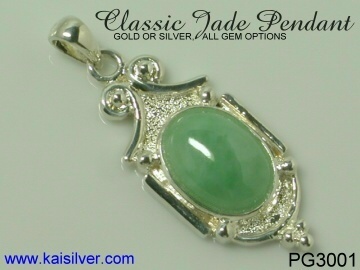
A timeless look for this classic gold or silver jade gemstone pendant. Shown with a natural and untreated jadeite gem from Burma, the pendant can be ordered with a dyed (treated) or untreated jadeite gem. Get more details for this gorgeous jade pendant ... here.
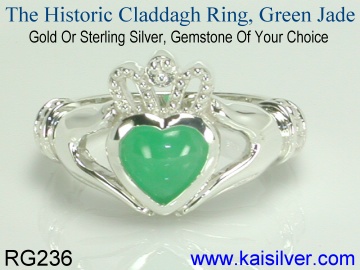
The claddagh ring is respected as the world's most meaningful jewel. The ring denotes love, togetherness and loyalty, it was first made around 4 centuries ago by an Irish slave. We craft both silver and gold claddagh rings with your choice of gem, more details ... here.
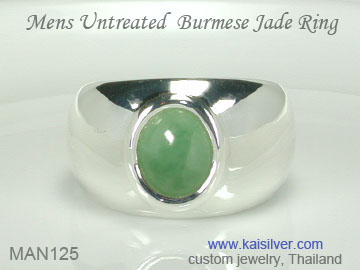
Both men and ladies are impressed with jade, Kaisilver can custom make your men's gold or 925 sterling silver ring with the design of your choice. You can specify the requirement of a dyed (treated) or untreated jade gemstone. Review our collection here.
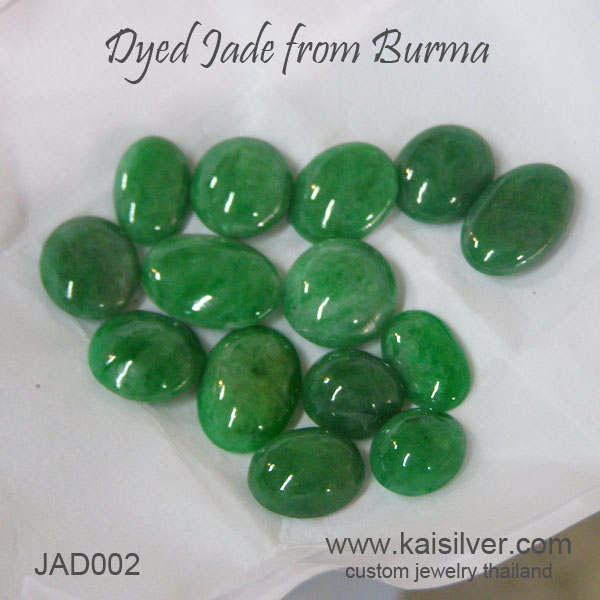
Treated jadeite that is dyed to enhance its color, can acquire the look of high quality jadeite gems. At Kaisilver we make a clear disclosure about treated and untreated jade, you can let us know your preference when placing an order, read more details of what we offer ... here.